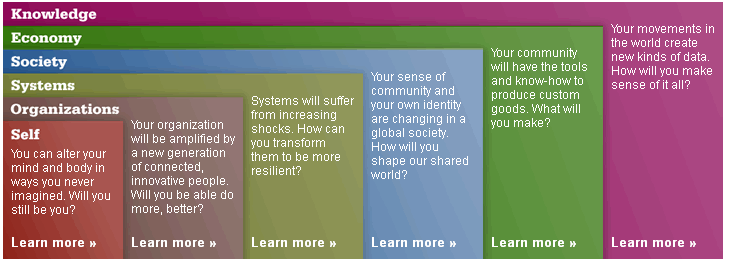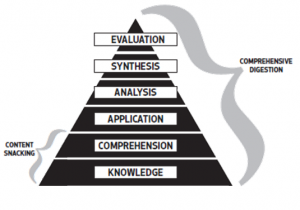This past week I was honored to be able to speak at the Council of Chief State School Officers’ (CCSSO) ‘Future of Learning’ meeting in New York. In attendance were a number of State Deputies and thought-leaders from Non-Governmental Organizations (NGO’s) and not-for-profit educational organizations.
I found it invigorating spending time with this group of educational leaders. Individually, they each provide direction and leadership to their states on a day-to-day basis and collectively, when together face-to-face, they generate ideas that are critical for leading the future of our educational system.
The day started with an overview of design by Bill Moggridge, Director of the Cooper-Hewitt National Design Museum, where the meeting was held. As the former Director for IDEO, Mr. Moggridge not only has an eye for design but also for innovation. It was a perfect kick-off for the meeting.
Next up was Jillian Darwish of KnowledgeWorks. Jillian provided an excellent overview of Knowledge Works 2020 Forecast: Creating the Future of Learning. She painted a picture of the future of learning by breaking it down into six key areas:
 Jillian then punted to me to help create the connective tissue from where we are today to where we are going. This is a daunting task as technologies and learning technologies are evolving so quickly, it is nearly impossible to predict what will be available for learners 24, 18, or even 12 months from now.
Jillian then punted to me to help create the connective tissue from where we are today to where we are going. This is a daunting task as technologies and learning technologies are evolving so quickly, it is nearly impossible to predict what will be available for learners 24, 18, or even 12 months from now.
With that, my approach was to focus on ‘The Big Five’ – the five big things that have the greatest potential to impact education in the next 6-24 months.
1. SOCIAL, IMMEDIATE, AND COMPETITIVE
Social Learning models are beginning to emerge in K-12 and Higher Education. In general, we are learning that students want to keep their social networks social and their learning focused. Enter organizations like Edmodo and Sophia. These networks are designed specifically for education and permit students to engage in collaborative and focused spaces – allowing learners to separate their learning networks from the personal networks.
Near ubiquitous internet access and mobile devices have changed the way learners look for and retrieve information. Gone are the days of the encyclopedia and the Dewy Decimal System (sorry Sheila {my mother-in-law who diligently served students as a school librarian throughout her career}). Instead, learners are pulling what they want when they want it – and it is more than print. The example I used was the work of Salman Khan and the Khan Academy. He is turning tutoring upside down (if you have 17 minutes, check him out on TED).
Many believe that gaming will revolutionize education. Like social networks, students that play massive multi-player games and serious games are still focused on the game itself vs the learning. Creating environments like this and assuming all students will want to learn this way is risky. It is more about the game mechanics than the game itself. That is, if we study all of the components from gaming (competitive, badging, leader boards, immediate cause and effect, etc) and we can weave these elements into existing and new instructional strategies – we have something big.
2. THE IMPORTANCE OF LEARNING DESIGN
When we started building online programs in the late 90’s, we did not know much about learning design specific to online and digital delivery. Most programs took on-ground lessons and put them on the web. As our programs have matured, so have our methods for testing and understanding how learners learn in online environments. We need to understand intrinsic and extrinsic cognitive load, we need to understand the importance of schema building, we need to understand task analysis and we need to develop learning models that are designed specifically for this modality of learning.
In addition to all of this, we cannot forget the importance of developing a solid assessment strategy that is designed specifically for online. We need to balance objective and subjective assessment and focus heavily on creating authentic, performance-based assessments that allow students to demonstrate their learning… rather than regurgitating facts.
Studying and evaluating learning design is critical to move the student performance needle. It is something that is impossible to do without teams and methodologies in place that focus specifically on this.
3. MOBILE LEARNING
Connected, everywhere, and always on. These three things will drastically change the way students learn and the way education is delivered. Immediacy and access to information changes the game. Bill Zobrist and I discussed this in a paper recently published by the SIIA in which we broke the learning that occurs on a mobile device into two categories:
Content Snacking – Quick-twitch learning that occurs when learners use flash cards, practice for a test, or search for a quick answer to a query – ‘knowledge-focused’ (i.e. mobile phone / hand-held apps).
Content Digestion – Comprehensive lesson-based content that delivers structured instructional content on a topic or range of topics up to a full online course experience (i.e. tablets).
Note: If you are attending the SIIA Ed Tech Industry Summit in San Francisco this week, pop by the mobile sessions and look for our QR code. Alternatively, if you would like to download our paper, Learning on the Run, click here.
4. TEACHER / INSTRUCTOR / & LEADER PREPAREDNESS
With 5.6 M students in Higher Education and 1.5 M students in K-12 taking one or more online courses, a demand is rapidly evolving for qualified online instructors. The instructional and assessment strategies required to teach in online and blended environments are very different than those of a traditional classroom. Traditional teacher pre-service programs do not currently prepare educators to teach in these environments and it is incumbent on all of us to help to push for programs that will prepare educators to teach through this medium.
It is also important that we work to prepare our educational leaders. This ranges from basic understanding for the community, legislators, and bureaucrats to strong leadership and administrative skills for school, district, and state leaders.
5. AMPLIFIED LEARNING (term borrowed from KnowledgeWork’s 2020 framework)
Learning 1.0 (L1.0) is characterized by an agrarian calendar, all students starting at the same time and all students finishing at the same time (September to June). If a student is ahead, they are forced to wait for the rest of the class and if a student falls behind, they need to figure out how to catch up, risk failure, and are almost certain not to achieve mastery.
L2.0 is characterized by the addition of online learning. In this model online and on-ground (L1.0) were mutually exclusive and sometimes offered in competition with each other.
L3.0 is characterized by blending L1.0 and L2.0 to a point where time is eliminated from the equation and students are able to co-mingle on-ground and online into a blended/emporium model (where many programs are heading today).
L4.0 or ‘Amplified Learning’ is a next generation learning approach that will allow for all learning to be competency-based and for time to be eliminated from the equation. It also takes into consideration prior-learning and provides learners credit for what they already know (i.e. Western Governors University). The best way to describe this is as a learning GPS. We provide students with the places they need to visit on their journey (learning outcomes), we provide them with the tools to get there (engaging learning content that can be leveled), a travel guide (trained teacher-facilitators), and we let them go. In some cases, students will take the shortest route. In others they will take detours to learn more and in some cases they may need to go back to get pre-requisite knowledge that they may have missed – but the key is that their learning events are captured and always aligned to the learning outcomes that have been set for them.
These are big challenges but 100% achievable. The technology is available today as is the mindshare to do it. What was energizing for me (how I started this post), was that a number of Deputies approached me after my presentation and they too were energized and positive about the possibilities. It is discussions like these – with all stakeholders at the table and the commitment to break down barriers and construct educational ecosystems that are beneficial for students – that will change not only education in the US but also our future as an economic leader.

